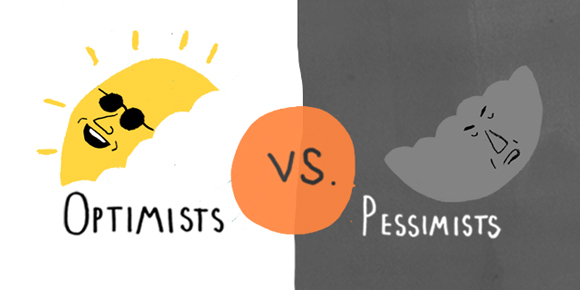In general, optimists are best suited to lead family-run entrepreneurial organizations. At least until disaster strikes. John A. Davis explains why both perspectives are so valuable.
Optimism and pessimism are strong, stable traits that reflect our coping strategies. We live in an uncertain world. To cope with uncertainty, most people basically assume that things will either turn out well (the optimists) or turn out badly (the pessimists).So here’s a question to ponder: Is it better to have an optimist or a pessimist leading your family organization? As I’ll show below, both have their own unique traits that can benefit a business. But they will do it in different ways, with different goals.
Which are you? Here’s a quick test. I plunk down two magazines in front of you. One, Time, has Warren Buffet on the cover, under the headline “The Optimist.” The other publication is ThePessimist.com, whose tagline is “Expecting the worst. Never disappointed.” Which do you pick up first?
It’s probably a good thing for us that so-called rationalists (tagline: “Why so emotional?”) are in the minority, because studies show that without optimism or pessimism people don’t accomplish as much. These natural traits motivate people to take action-different actions, but at least action.
Are you a pessimist?
If you’re a pessimist, you tend to focus on safety and security. Pessimism drives you to seek and find safe havens, establish clear advantages, and protect resources. When pessimistic about needed economic recovery, for instance, families save money and companies build war chests. When the news is bad and likely to get worse, a pessimist is your best ally because pessimists thrive on fixing errors.
To get the most out of the pessimist in your family-owned company, researchers say, you need to provide “targeted negative feedback” from a trusted authority. Pointing out what has gone wrong or what’s less than perfect will motivate the pessimist to innovate products, improve plans, and solve problems. For this reason, pessimists can make good operational leaders. But pessimists in the corner office or leading the family are less likely to foster a culture of growth, risk taking, and wealth creation.
According to Jeremy Dean, a researcher at University College London, optimists prefer to think about how they and others can advance and grow. Optimists also have larger social networks, solve problems cooperatively, and are more likely to seek help in difficult situations. They make good spouses. People with optimistic spouses were healthier in a 2014 study by researchers at the University of Michigan.1 To energize an optimist, positive feedback is absolutely essential, because the optimist builds on incremental achievements and a sense of positive movement.
Choose optimists to lead growth activities in your family organization. Entrepreneurs, for example, are much more likely to be optimists. But if you choose an optimistic business leader, you should probably pair them with “reality testers,” not necessarily authority figures, advises University of Pennsylvania professor Martin Seligman, the father of positive psychology.
For decades, scientists regarded optimism and pessimism as fixed traits we are born with. But last year, researchers at a German University reported that 18-39 year-olds were more optimistic than people 40-64, and far more than people 65 and older.2 For reasons we don’t fully understand but can appreciate, life experience turns some people into pessimists. By the way, the same study of 40,000 people also found that grumpy people live longer. Their caregivers? You guessed it: Optimists.
Use the power of both traits
Leaders, whatever their orientation, need to learn to harness the power of both traits. “In a striking turnaround,” writes Annie Murphy Paul in Psychology Today, “science now sees optimism and pessimism not as good or bad outlooks you’re born with but as mindsets to adopt as situations demand.”
When testing strategic plans, deploy defensive pessimism, imagining all the things that can go wrong in the future. But when the task requires flexibility and had work toward uncertain goals, build teams with optimists.
As a determined optimist who has grown a bit more pessimistic during my life, I do want to share one important finding from my 35 years of field research: Effective long-term planning and investment requires an optimistic approach, with contingency planning by pessimists?because things never go exactly as you want them to.
Footnotes:
1. Kim et al., Journal of Psychosomatic Research, 2014. Vol. 76 Issue 6. 2. Lang et al., Psychology and Aging 2013. Vol. 28, No. 1.
